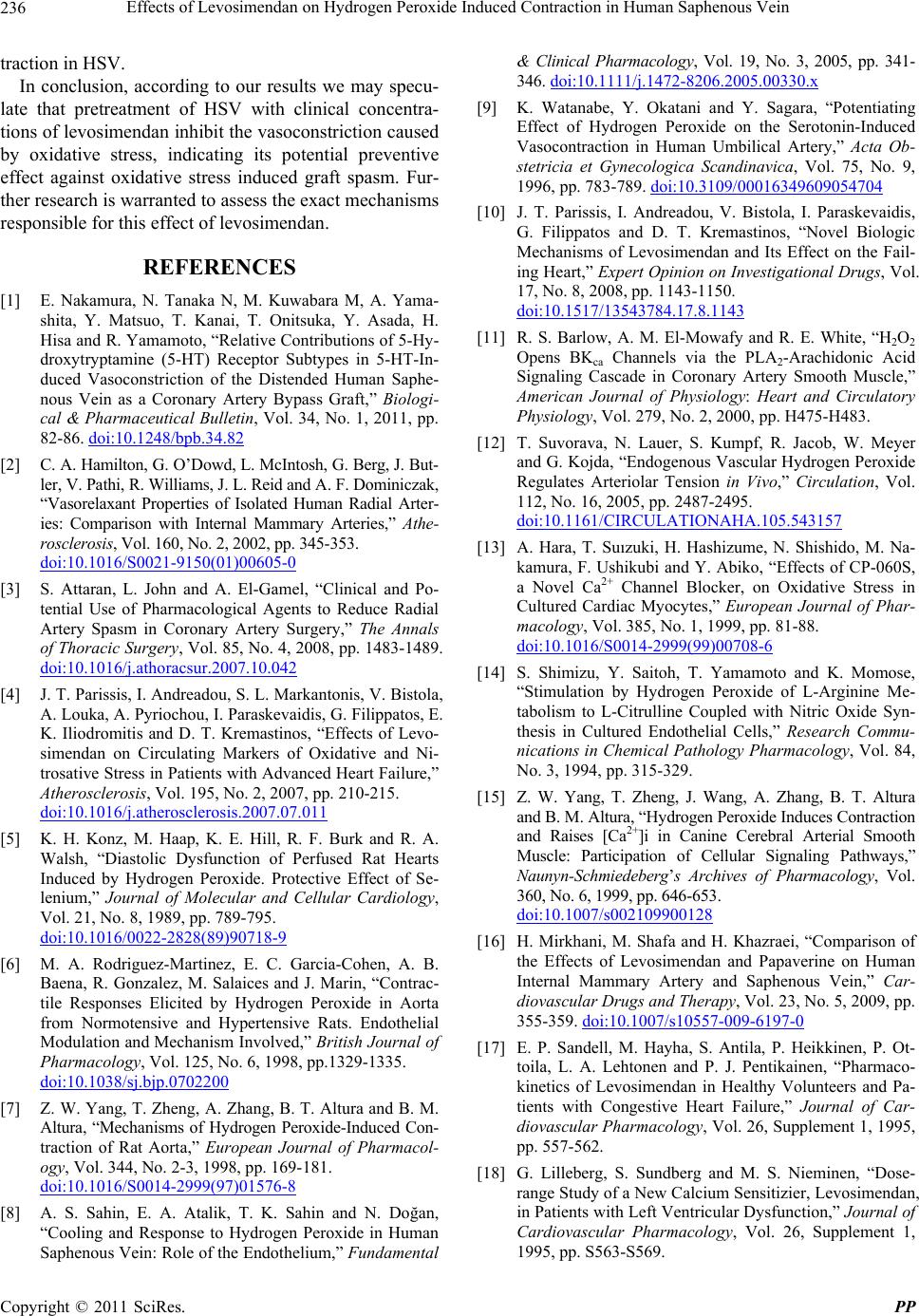
Effects of Levosimendan on Hydrogen Peroxide Induced Contraction in Human Saphenous Vein
236
traction in HSV.
In conclusion, according to our results we may specu-
late that pretreatment of HSV with clinical concentra-
tions of levosimendan inhibit the vasoconstriction caused
by oxidative stress, indicating its potential preventive
effect against oxidative stress induced graft spasm. Fur-
ther research is warranted to assess the exact mechanisms
responsible for this effect of levosimendan.
REFERENCES
[1] E. Nakamura, N. Tanaka N, M. Kuwabara M, A. Yama-
shita, Y. Matsuo, T. Kanai, T. Onitsuka, Y. Asada, H.
Hisa and R. Yamamoto, “Relative Contributions of 5-Hy-
droxytryptamine (5-HT) Receptor Subtypes in 5-HT-In-
duced Vasoconstriction of the Distended Human Saphe-
nous Vein as a Coronary Artery Bypass Graft,” Biologi-
cal & Pharmaceutical Bulletin, Vol. 34, No. 1, 2011, pp.
82-86. doi:10.1248/bpb.34.82
[2] C. A. Hamilton, G. O’Dowd, L. McIntosh, G. Berg, J. But-
ler, V. Pathi, R. Williams, J. L. Reid and A. F. Dominiczak,
“Vasorelaxant Properties of Isolated Human Radial Arter-
ies: Comparison with Internal Mammary Arteries,” Athe-
rosclerosi s, Vol. 160, No. 2, 2002, pp. 345-353.
doi:10.1016/S0021-9150(01)00605-0
[3] S. Attaran, L. John and A. El-Gamel, “Clinical and Po-
tential Use of Pharmacological Agents to Reduce Radial
Artery Spasm in Coronary Artery Surgery,” The Annals
of Thoracic Surgery, Vol. 85, No. 4, 2008, pp. 1483-1489.
doi:10.1016/j.athoracsur.2007.10.042
[4] J. T. Parissis, I. Andreadou, S. L. Markantonis, V. Bistola,
A. Louka, A. Pyriochou, I. Paraskevaidis, G. Filippatos, E.
K. Iliodromitis and D. T. Kremastinos, “Effects of Levo-
simendan on Circulating Markers of Oxidative and Ni-
trosative Stress in Patients with Advanced Heart Failure,”
Atherosclerosis, Vol. 195, No. 2, 2007, pp. 210-215.
doi:10.1016/j.atherosclerosis.2007.07.011
[5] K. H. Konz, M. Haap, K. E. Hill, R. F. Burk and R. A.
Walsh, “Diastolic Dysfunction of Perfused Rat Hearts
Induced by Hydrogen Peroxide. Protective Effect of Se-
lenium,” Journal of Molecular and Cellular Cardiology,
Vol. 21, No. 8, 1989, pp. 789-795.
doi:10.1016/0022-2828(89)90718-9
[6] M. A. Rodriguez-Martinez, E. C. Garcia-Cohen, A. B.
Baena, R. Gonzalez, M. Salaices and J. Marin, “Contrac-
tile Responses Elicited by Hydrogen Peroxide in Aorta
from Normotensive and Hypertensive Rats. Endothelial
Modulation and Mechanism Involved,” British Journal of
Pharmacology, Vol. 125, No. 6, 1998, pp.1329-1335.
doi:10.1038/sj.bjp.0702200
[7] Z. W. Yang, T. Zheng, A. Zhang, B. T. Altura and B. M.
Altura, “Mechanisms of Hydrogen Peroxide-Induced Con-
traction of Rat Aorta,” European Journal of Pharmacol-
ogy, Vol. 344, No. 2-3, 1998, pp. 169-181.
doi:10.1016/S0014-2999(97)01576-8
[8] A. S. Sahin, E. A. Atalik, T. K. Sahin and N. Doğan,
“Cooling and Response to Hydrogen Peroxide in Human
Saphenous Vein: Role of the Endothelium,” Fundamental
& Clinical Pharmacology, Vol. 19, No. 3, 2005, pp. 341-
346. doi:10.1111/j.1472-8206.2005.00330.x
[9] K. Watanabe, Y. Okatani and Y. Sagara, “Potentiating
Effect of Hydrogen Peroxide on the Serotonin-Induced
Vasocontraction in Human Umbilical Artery,” Acta Ob-
stetricia et Gynecologica Scandinavica, Vol. 75, No. 9,
1996, pp. 783-789. doi:10.3109/00016349609054704
[10] J. T. Parissis, I. Andreadou, V. Bistola, I. Paraskevaidis,
G. Filippatos and D. T. Kremastinos, “Novel Biologic
Mechanisms of Levosimendan and Its Effect on the Fail-
ing Heart,” Expert Opinion on Investigational Drugs, Vol.
17, No. 8, 2008, pp. 1143-1150.
doi:10.1517/13543784.17.8.1143
[11] R. S. Barlow, A. M. El-Mowafy and R. E. White, “H2O2
Opens BKca Channels via the PLA2-Arachidonic Acid
Signaling Cascade in Coronary Artery Smooth Muscle,”
American Journal of Physiology: Heart and Circulatory
Physiology, Vol. 279, No. 2, 2000, pp. H475-H483.
[12] T. Suvorava, N. Lauer, S. Kumpf, R. Jacob, W. Meyer
and G. Kojda, “Endogenous Vascular Hydrogen Peroxide
Regulates Arteriolar Tension in Vivo,” Circulation, Vol.
112, No. 16, 2005, pp. 2487-2495.
doi:10.1161/CIRCULATIONAHA.105.543157
[13] A. Hara, T. Suızuki, H. Hashizume, N. Shishido, M. Na-
kamura, F. Ushikubi and Y. Abiko, “Effects of CP-060S,
a Novel Ca2+ Channel Blocker, on Oxidative Stress in
Cultured Cardiac Myocytes,” European Journal of Phar-
macology, Vol. 385, No. 1, 1999, pp. 81-88.
doi:10.1016/S0014-2999(99)00708-6
[14] S. Shimizu, Y. Saitoh, T. Yamamoto and K. Momose,
“Stimulation by Hydrogen Peroxide of L-Arginine Me-
tabolism to L-Citrulline Coupled with Nitric Oxide Syn-
thesis in Cultured Endothelial Cells,” Research Commu-
nications in Chemical Pathology Pharmacology, Vol. 84,
No. 3, 1994, pp. 315-329.
[15] Z. W. Yang, T. Zheng, J. Wang, A. Zhang, B. T. Altura
and B. M. Altura, “Hydrogen Peroxide Induces Contraction
and Raises [Ca2+]i in Canine Cerebral Arterial Smooth
Muscle: Participation of Cellular Signaling Pathways,”
Naunyn-Schmiedeberg’s Archives of Pharmacology, Vol.
360, No. 6, 1999, pp. 646-653.
doi:10.1007/s002109900128
[16] H. Mirkhani, M. Shafa and H. Khazraei, “Comparison of
the Effects of Levosimendan and Papaverine on Human
Internal Mammary Artery and Saphenous Vein,” Car-
diovascular Drugs and Therapy, Vol. 23, No. 5, 2009, pp.
355-359. doi:10.1007/s10557-009-6197-0
[17] E. P. Sandell, M. Hayha, S. Antila, P. Heikkinen, P. Ot-
toila, L. A. Lehtonen and P. J. Pentikainen, “Pharmaco-
kinetics of Levosimendan in Healthy Volunteers and Pa-
tients with Congestive Heart Failure,” Journal of Car-
diovascular Pharmacology, Vol. 26, Supplement 1, 1995,
pp. 557-562.
[18] G. Lilleberg, S. Sundberg and M. S. Nieminen, “Dose-
range Study of a New Calcium Sensitizier, Levosimendan,
in Patients with Left Ventricular Dysfunction,” Journal of
Cardiovascular Pharmacology, Vol. 26, Supplement 1,
1995, pp. S563-S569.
Copyright © 2011 SciRes. PP